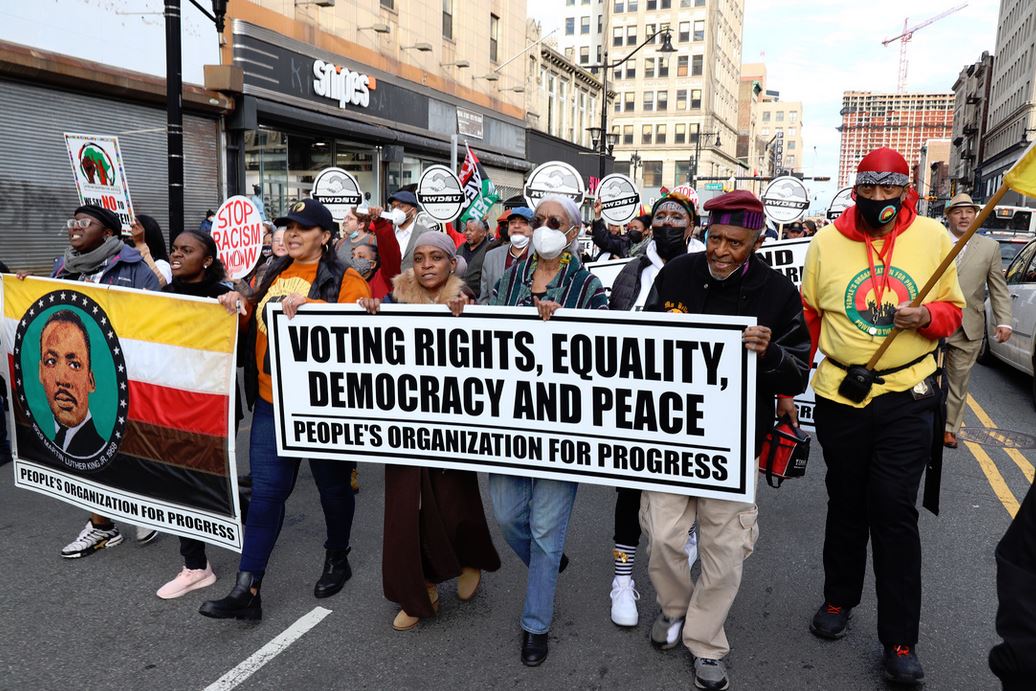By Walter Elliott
NEWARK – The People’s Organization for Progress more than revived its annual commemoration of Dr. Martin Luther King, Jr.’s 1968 assassination here in downtown Newark on April 4.
POP resumed its COVID pandemic-interrupted observance with a march Monday afternoon and night from the Seated Lincoln statue at 12 Springfield Ave., to the Peter Rodino Federal Building at 970 Broad St./Kenneth Gibson Blvd. and back to the slain human rights leader’s statue at 495 MLK Blvd.
The three-hour, five-minute event – which drew participants from three states and represented some of the 139 endorsing organizations – started off with voices.
POP founder Lawrence “Larry” Hamm warmed up the gathering crowd before The Historic Courthouse with chants just after 4 p.m. The voices continued by public speakers including RWDSU Local 108 President Charles Hall and Newark Mayor Ras Baraka.
They and other speakers were reminding the growing crowd of marchers that they were more than continuing a tradition. They were calling for action on urgent matters and longstanding conditions.
“(We need) to draw attention to issues of voting rights,” said Hamm beforehand, “the need for racial justice and equality, the need to preserve democracy in this country and the need to end war.”
“If I want anyone to be with me in a foxhole, it would be the POP,” said Hall. “It’s time we begin to fight for our rights, including the right to vote, In the past few years, we had three Supreme Court of the United States justices appointed who want to roll things back some 60 years.”
“Those who want to take our rights back are organized,” said Baraka. “We may have our disagreements, but it is what we agree on that unites us.”
The event ended with a moment of silence before King’s statue at the new Dr. Martin Luther King, Jr. Justice Building at 7:05 p.m. Eastern Daylight Savings Time.
It was 7:05 p.m. Central DST when King, 39, was declared dead by doctors at Memphis’ St. Joseph’s Hospital 54 years ago. He had been rushed there from the Lorraine Motel balcony, where he was shot 6:01 p.m. local time, for emergency surgery.
Dr. King was in Memphis to support that city’s sanitation workers’ 25-day-old strike. The AFSCME Local 1733 members were protesting poor working conditions and unequal treatment.
The 1965 Nobel Peace Prize winner was last in Newark and Orange March 27, 1968. He made a 12-stop whirlwind tour, including in Paterson and Jersey City mainly to promote his Poor Peoples Campaign and upcoming march on Washington, D.C.
The county had slightly moved its 2015 King statue since POP had last gathered there. The namesake Dr. King Justice Building was constructed behind it during the pandemic.
In between was the “Million People’s March for Voting Rights, Equality, Democracy and Peace” itself.
“Local Talk” counted 300 men, women and children stepping off from the “Seated Lincoln Plaza” 5:32 p.m.
Marchers – escorted and guided by POP organizers Newark police vehicles – walked east on West Market Street and south on Broad/Gibson to the Rodino Building. They then wheeled 180 degrees onto northbound Broad/Gibson and West Market to 495 King Blvd.
They had covered the 1.2-mile, five-turn, 19-block route in 55 minutes. They paused three times, at traffic intersections, for chants and a fourth to let three University Hospital ambulances through West Market Street.
NPD, for that hour, had detoured traffic at that rush hour’s height, including buses on 34 New Jersey Transit and CoachUSA routes. Riders on 18 of NJTransit’s routes were also on their first workday of a new timetable.
The march was among several area events that have resumed publicly marking Dr. King’s death, and his visit the previous week. The Orange Public Library, for example, hosted an “African-American History Program” in its auditorium April 5.
POP, however, led up to its march this year with a March 27 virtual town hall meeting and was a guest on Rutgers-Newark WRNU ” All Politics Are Local” radio broadcast on April 1.
The event had meanwhile received over 130 endorsements from labor unions, activist organizations, school clubs, non-profits and faith communities from New York and across New Jersey to Pennsylvania. That count, to the understanding of “Local Talk,” reached 139 on or by April 4.
Pam Africa, of Philadelphia’s MOVE, and a representative of Brooklyn, N.Y.-based Dec. 12 Movement respectively spoke before or after the march. Hamm and organizers kept the event on track to allow “the Camden and Atlantic City delegations” walk and depart before sunset.
Naomi Figurora was among the 20 Journey for Justice Alliance members from Camden and was the first of three who spoke before the march.
“People look at my curly hair but they wouldn’t want to go through what I have to go through with it,” said Figurora while wearing an “Equity or Else” t-shirt. “Why should we put up being told that we and our schools are ‘good enough?’ “
The National Action Network’s Newton County, Ga, chapter joined their New Jersey colleagues on the endorsement roll.
Hall brought 12 Local 108 members with him to march and hold RWDSU and African-American Heritage Parades Organization signs.
Other individuals and groups seen by “Local Talk” included the African Diaspora for Justice, Black is Back Coalition for Social Justice, Peace and Reparations; Faith in New Jersey, Irvington Branch NAACP, Jewish Voice for Peace, Latino Action Network, Montclair Adjunct Union AFT Local 6025, NAN, Progressive Democrats of New Jersey, Seton Hall University Martin Luther King Scholarship Organization and Voter Choice New Jersey.
POP’s coming activities, including its Monday demonstrations, are found on its website.


